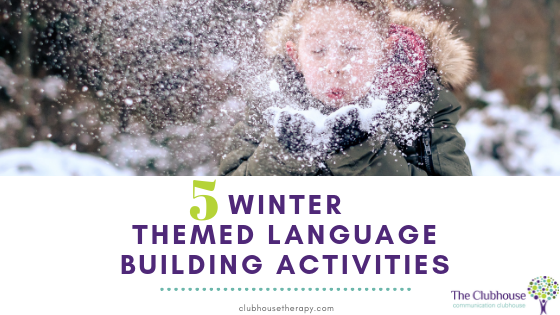While the freezing temperatures of Chicagoland winters are not typically a favorite, wintertime brings a change of season and new opportunities for your child to learn and practice language skills in the home environment. Here are some ways to enjoy winter (both inside and outside) while working on expressive and receptive language skills!
- Practice organization, sequencing, and following directions by planning and building a snowman together.
- Before going outside to brave the cold, create a written plan with your child. Prompt your child by asking, “What do we need to do first?” This is a great opportunity to include sequence concepts, such as: first, next, last. Once your plan is complete, go outside and build your snowman! Encourage your child to follow the directions you created – while also allowing for creative freedom, of course. If temperatures are too cold to venture outside, try building and coloring the fun indoor snowman activity included below!
- Provide your child with an enriching language opportunity by building a gingerbread house together.
- This activity is a great way to target sequencing and task organization, as well as expressive language and vocabulary skills. Have your child tell a story about the gingerbread man in his gingerbread house. This is also a great activity to target basic concepts, such as: “Put the candy cane around the door. Put the tree next to the house. Find the small gumdrop and put it above the window.”
- Read winter-themed books with your child.
- Classic stories include Frosty the Snowman and The Gingerbread Man, which pair well with the activities listed above. While telling the story, have your child identify vocabulary items by asking “What’s that?” To encourage practice of action words, ask your child, “What is she doing?” Once you finish reading the story, ask your child to retell the story. You can prompt them with closed questions, such as, “What made the snowman come to life?” or open-ended questions, such as, “How did the story start?” See a list of our favorite winter-themed books below!
- Use a winter-themed sensory bin to target language skills.
- Your bin might include cotton balls, white beads, white pom-pom balls, Styrofoam packing peanuts, or rice to represent snow. Hide toys, cards, or other small household objects within the bin for your child to find, label, and describe. This is a great way to allow your child to explore a variety of tactile textures while also building on language and description skills!
- Play BINGO with winter vocabulary pictures.
- Instead of simply saying a word for your child to find, provide a descriptive clue for them to identify, such as: “Find something that you wear on your head when it’s cold outside.” Then have them label the item before putting down their BINGO chip. This is a great way to target language comprehension and vocabulary. See the example Winter Words BINGO sheet below!
Winter Vocabulary List:
Arctic Blanket
Blizzard Blustery
Boots Cap
Chilly Coat
Cold December
Dreary Ear muffs
February Fireplace
Flannel Fleece
Flurries Frigid
Frozen Gloves
Hot chocolate Ice skates
Icicle Jacket
January Log
Mittens Polar bear
Scarf Ski
Sled Slippery
Slush Snow
Snowball Snowflake
Shovel Socks
Sweater Winter
Winter-Themed Book Suggestions:
- The Big Snowball by Wendy Cheyette Lewison
- The Gingerbread Man by Catherine McCafferty
- Frosty the Snowman by Diane Muldrow
- The Snowy Day by Ezra Jack Keats
-
The Hat by Jan Brett
- Snowmen All Year by Caralyn Buehner
By:Shelby Gunderson, M.S., CF-SLP

